Recruitment and Selection: Report on Key HR Processes and Practices
VerifiedAdded on 2020/06/06
|11
|2490
|144
Report
AI Summary
This report provides a detailed overview of recruitment and selection processes within organizations. It begins by defining recruitment and selection, differentiating between internal and external recruitment sources, and illustrating these concepts with examples from Tesco and Oxfam. The report then explores the impact of legal and regulatory frameworks, including the Equal Pay Act, Sex Discrimination Act, Employment Act, and Race Relations Act. A job description and personal specification for a sales assistant role at Oxfam are presented, followed by an analysis of activities involved in the selection interview process. Finally, the report outlines a nine-step interview planning process, covering candidate shortlisting, question creation, venue selection, and evaluation techniques. This report offers valuable insights into key HR processes and practices.
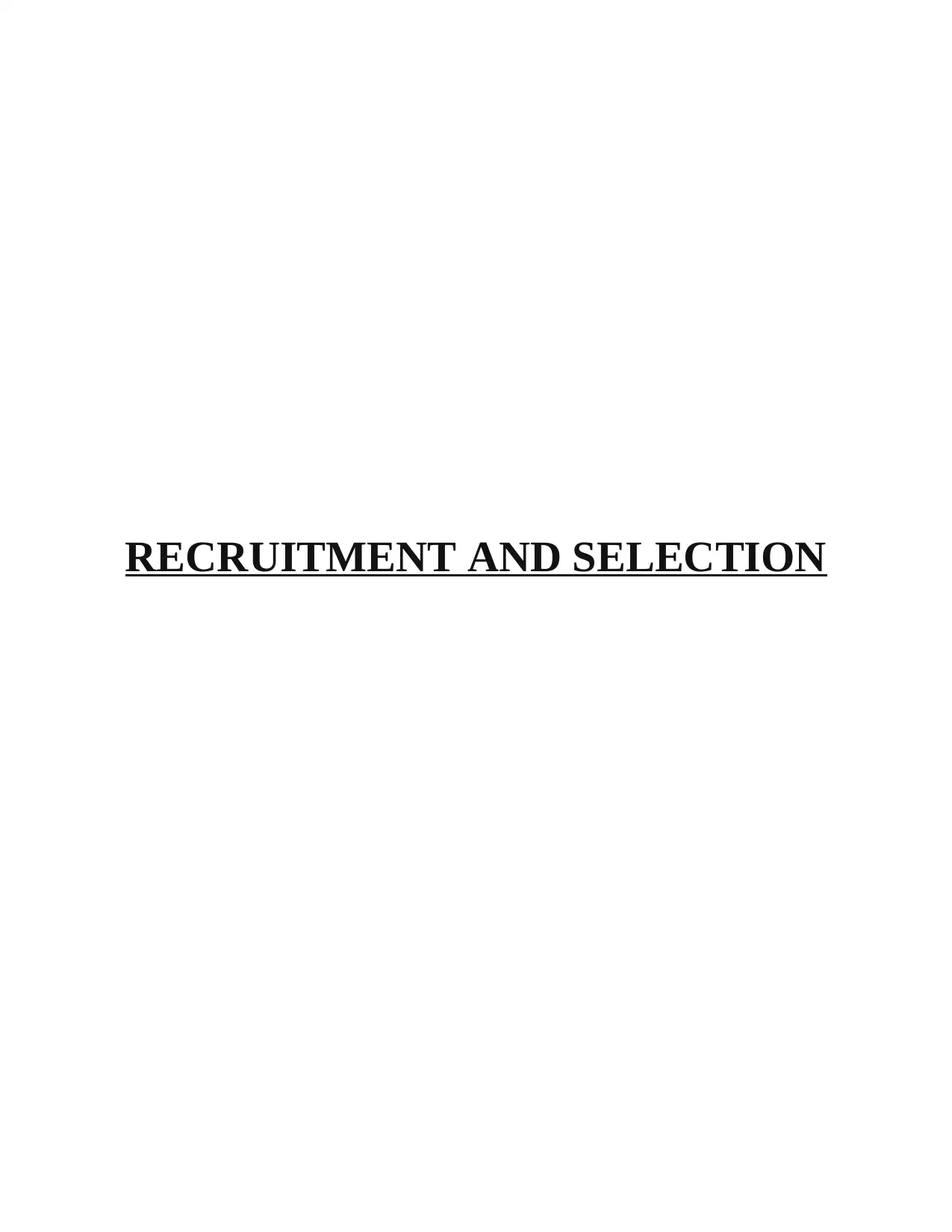
RECRUITMENT AND SELECTION
Paraphrase This Document
Need a fresh take? Get an instant paraphrase of this document with our AI Paraphraser
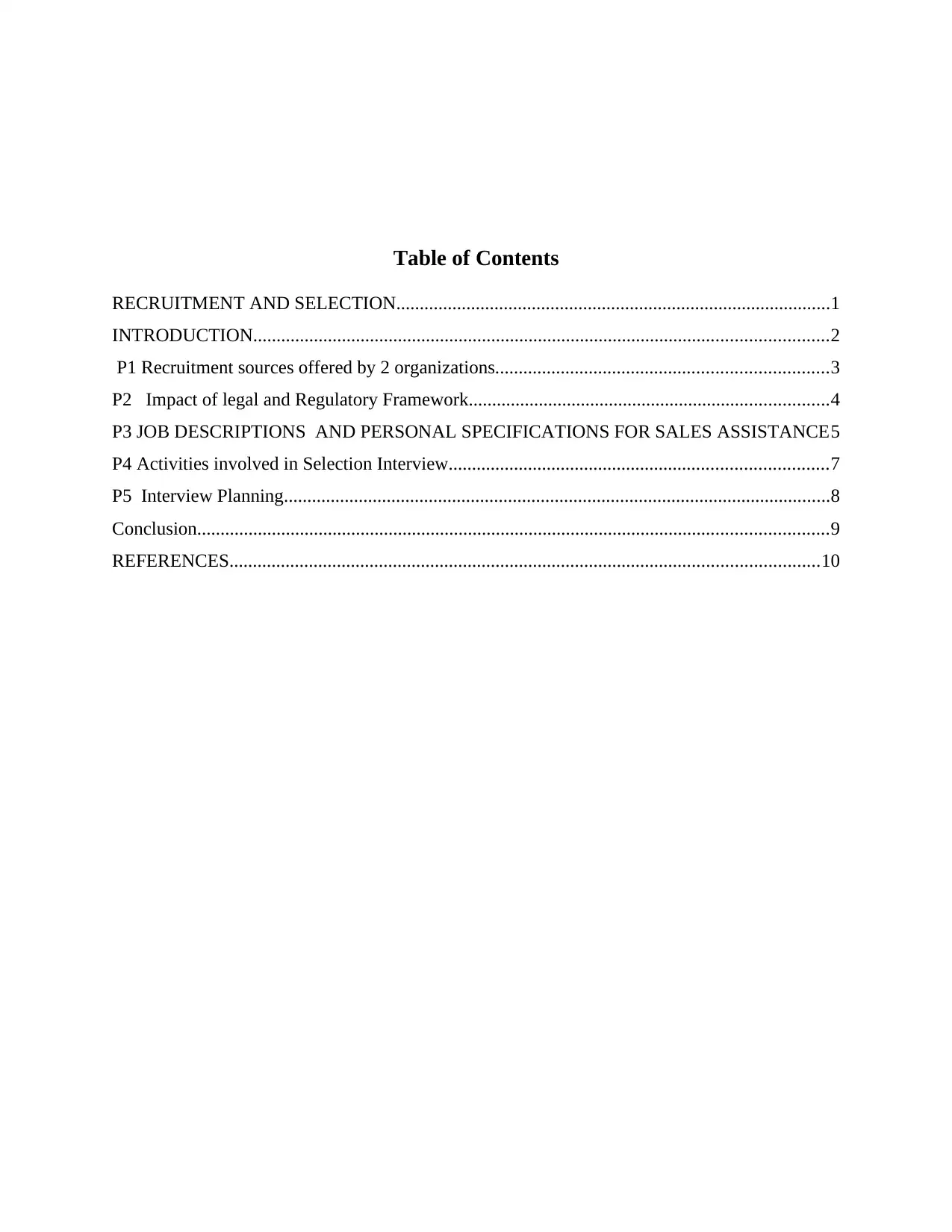
Table of Contents
RECRUITMENT AND SELECTION.............................................................................................1
INTRODUCTION...........................................................................................................................2
P1 Recruitment sources offered by 2 organizations.......................................................................3
P2 Impact of legal and Regulatory Framework.............................................................................4
P3 JOB DESCRIPTIONS AND PERSONAL SPECIFICATIONS FOR SALES ASSISTANCE5
P4 Activities involved in Selection Interview.................................................................................7
P5 Interview Planning.....................................................................................................................8
Conclusion.......................................................................................................................................9
REFERENCES..............................................................................................................................10
RECRUITMENT AND SELECTION.............................................................................................1
INTRODUCTION...........................................................................................................................2
P1 Recruitment sources offered by 2 organizations.......................................................................3
P2 Impact of legal and Regulatory Framework.............................................................................4
P3 JOB DESCRIPTIONS AND PERSONAL SPECIFICATIONS FOR SALES ASSISTANCE5
P4 Activities involved in Selection Interview.................................................................................7
P5 Interview Planning.....................................................................................................................8
Conclusion.......................................................................................................................................9
REFERENCES..............................................................................................................................10

⊘ This is a preview!⊘
Do you want full access?
Subscribe today to unlock all pages.

Trusted by 1+ million students worldwide
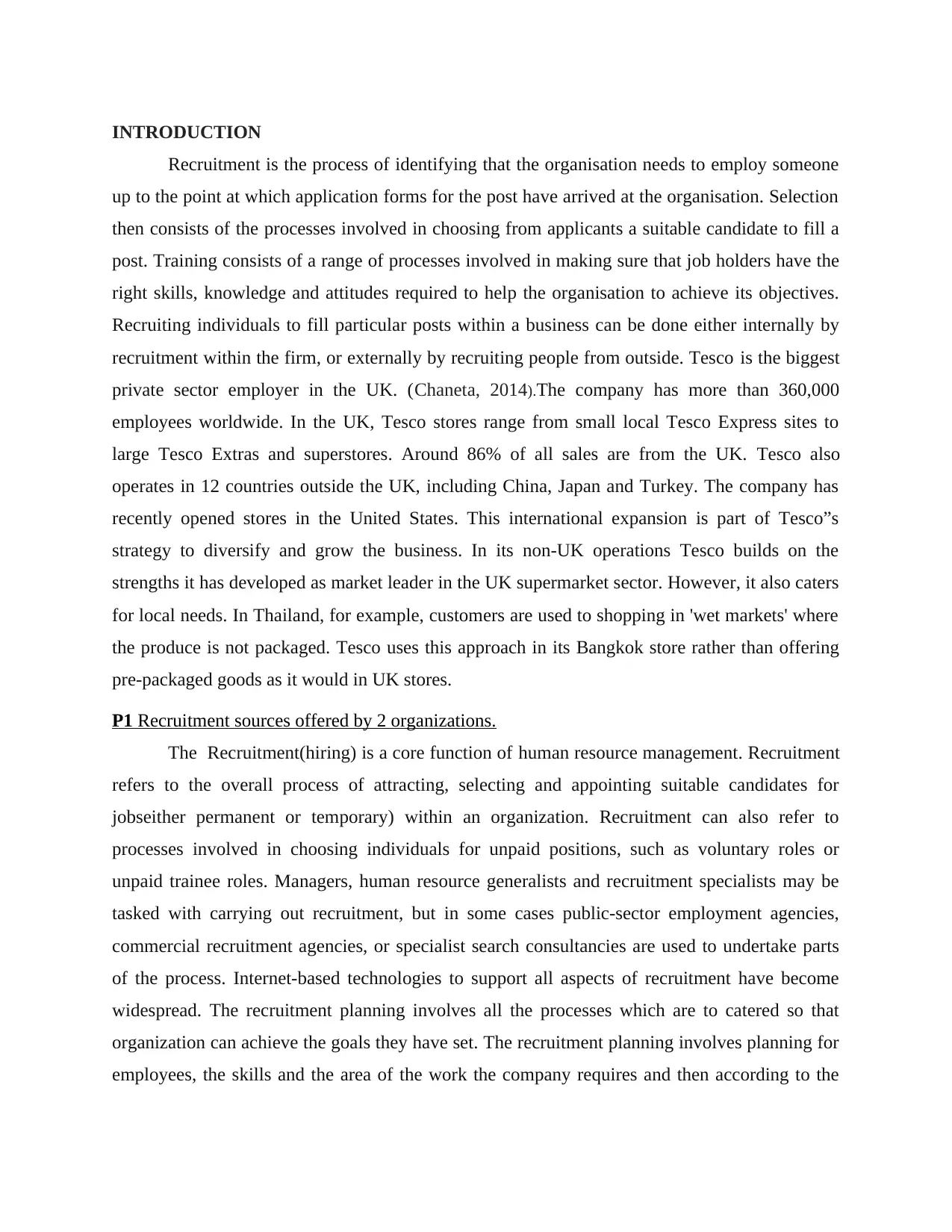
INTRODUCTION
Recruitment is the process of identifying that the organisation needs to employ someone
up to the point at which application forms for the post have arrived at the organisation. Selection
then consists of the processes involved in choosing from applicants a suitable candidate to fill a
post. Training consists of a range of processes involved in making sure that job holders have the
right skills, knowledge and attitudes required to help the organisation to achieve its objectives.
Recruiting individuals to fill particular posts within a business can be done either internally by
recruitment within the firm, or externally by recruiting people from outside. Tesco is the biggest
private sector employer in the UK. (Chaneta, 2014).The company has more than 360,000
employees worldwide. In the UK, Tesco stores range from small local Tesco Express sites to
large Tesco Extras and superstores. Around 86% of all sales are from the UK. Tesco also
operates in 12 countries outside the UK, including China, Japan and Turkey. The company has
recently opened stores in the United States. This international expansion is part of Tesco”s
strategy to diversify and grow the business. In its non-UK operations Tesco builds on the
strengths it has developed as market leader in the UK supermarket sector. However, it also caters
for local needs. In Thailand, for example, customers are used to shopping in 'wet markets' where
the produce is not packaged. Tesco uses this approach in its Bangkok store rather than offering
pre-packaged goods as it would in UK stores.
P1 Recruitment sources offered by 2 organizations.
The Recruitment(hiring) is a core function of human resource management. Recruitment
refers to the overall process of attracting, selecting and appointing suitable candidates for
jobseither permanent or temporary) within an organization. Recruitment can also refer to
processes involved in choosing individuals for unpaid positions, such as voluntary roles or
unpaid trainee roles. Managers, human resource generalists and recruitment specialists may be
tasked with carrying out recruitment, but in some cases public-sector employment agencies,
commercial recruitment agencies, or specialist search consultancies are used to undertake parts
of the process. Internet-based technologies to support all aspects of recruitment have become
widespread. The recruitment planning involves all the processes which are to catered so that
organization can achieve the goals they have set. The recruitment planning involves planning for
employees, the skills and the area of the work the company requires and then according to the
Recruitment is the process of identifying that the organisation needs to employ someone
up to the point at which application forms for the post have arrived at the organisation. Selection
then consists of the processes involved in choosing from applicants a suitable candidate to fill a
post. Training consists of a range of processes involved in making sure that job holders have the
right skills, knowledge and attitudes required to help the organisation to achieve its objectives.
Recruiting individuals to fill particular posts within a business can be done either internally by
recruitment within the firm, or externally by recruiting people from outside. Tesco is the biggest
private sector employer in the UK. (Chaneta, 2014).The company has more than 360,000
employees worldwide. In the UK, Tesco stores range from small local Tesco Express sites to
large Tesco Extras and superstores. Around 86% of all sales are from the UK. Tesco also
operates in 12 countries outside the UK, including China, Japan and Turkey. The company has
recently opened stores in the United States. This international expansion is part of Tesco”s
strategy to diversify and grow the business. In its non-UK operations Tesco builds on the
strengths it has developed as market leader in the UK supermarket sector. However, it also caters
for local needs. In Thailand, for example, customers are used to shopping in 'wet markets' where
the produce is not packaged. Tesco uses this approach in its Bangkok store rather than offering
pre-packaged goods as it would in UK stores.
P1 Recruitment sources offered by 2 organizations.
The Recruitment(hiring) is a core function of human resource management. Recruitment
refers to the overall process of attracting, selecting and appointing suitable candidates for
jobseither permanent or temporary) within an organization. Recruitment can also refer to
processes involved in choosing individuals for unpaid positions, such as voluntary roles or
unpaid trainee roles. Managers, human resource generalists and recruitment specialists may be
tasked with carrying out recruitment, but in some cases public-sector employment agencies,
commercial recruitment agencies, or specialist search consultancies are used to undertake parts
of the process. Internet-based technologies to support all aspects of recruitment have become
widespread. The recruitment planning involves all the processes which are to catered so that
organization can achieve the goals they have set. The recruitment planning involves planning for
employees, the skills and the area of the work the company requires and then according to the
Paraphrase This Document
Need a fresh take? Get an instant paraphrase of this document with our AI Paraphraser
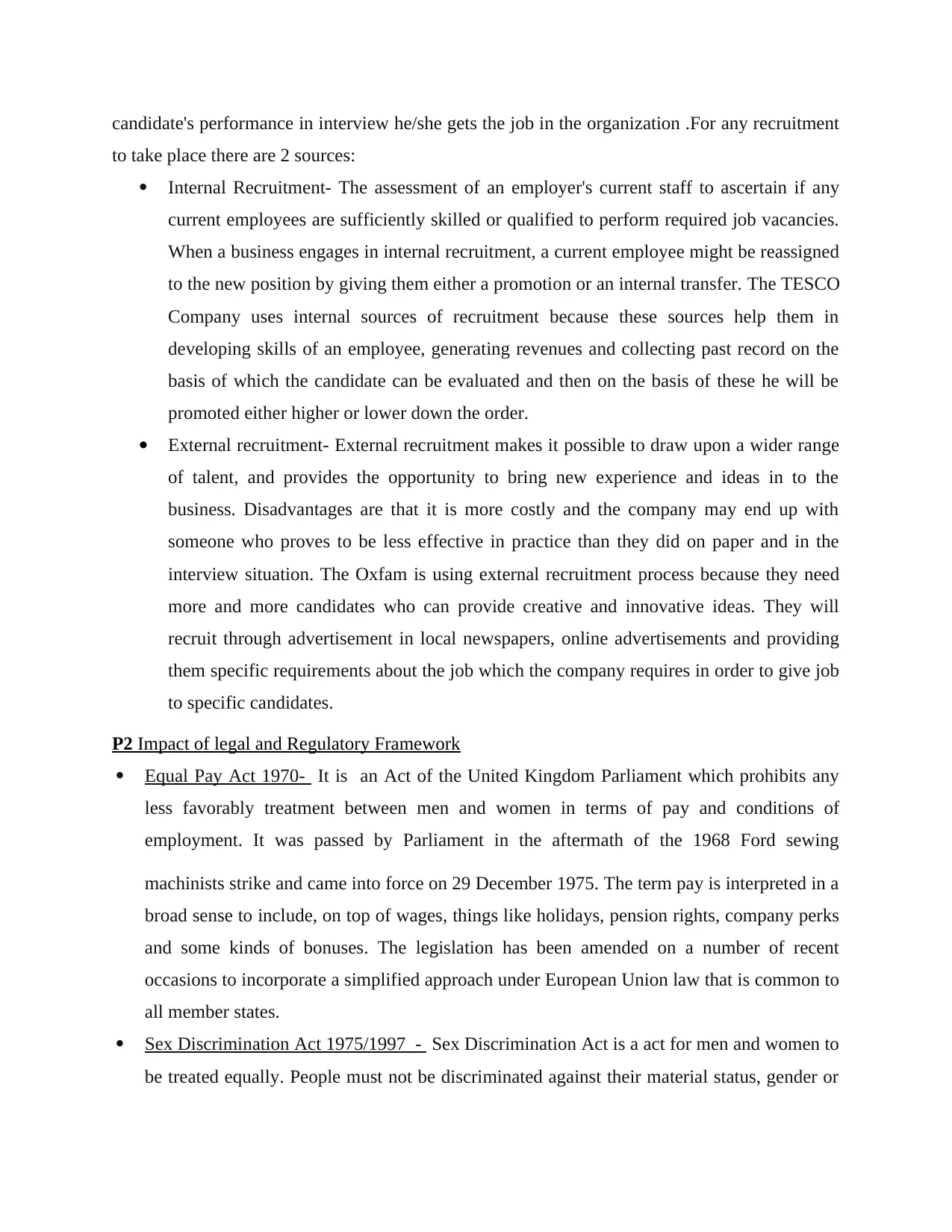
candidate's performance in interview he/she gets the job in the organization .For any recruitment
to take place there are 2 sources:
Internal Recruitment- The assessment of an employer's current staff to ascertain if any
current employees are sufficiently skilled or qualified to perform required job vacancies.
When a business engages in internal recruitment, a current employee might be reassigned
to the new position by giving them either a promotion or an internal transfer. The TESCO
Company uses internal sources of recruitment because these sources help them in
developing skills of an employee, generating revenues and collecting past record on the
basis of which the candidate can be evaluated and then on the basis of these he will be
promoted either higher or lower down the order.
External recruitment- External recruitment makes it possible to draw upon a wider range
of talent, and provides the opportunity to bring new experience and ideas in to the
business. Disadvantages are that it is more costly and the company may end up with
someone who proves to be less effective in practice than they did on paper and in the
interview situation. The Oxfam is using external recruitment process because they need
more and more candidates who can provide creative and innovative ideas. They will
recruit through advertisement in local newspapers, online advertisements and providing
them specific requirements about the job which the company requires in order to give job
to specific candidates.
P2 Impact of legal and Regulatory Framework
Equal Pay Act 1970- It is an Act of the United Kingdom Parliament which prohibits any
less favorably treatment between men and women in terms of pay and conditions of
employment. It was passed by Parliament in the aftermath of the 1968 Ford sewing
machinists strike and came into force on 29 December 1975. The term pay is interpreted in a
broad sense to include, on top of wages, things like holidays, pension rights, company perks
and some kinds of bonuses. The legislation has been amended on a number of recent
occasions to incorporate a simplified approach under European Union law that is common to
all member states.
Sex Discrimination Act 1975/1997 - Sex Discrimination Act is a act for men and women to
be treated equally. People must not be discriminated against their material status, gender or
to take place there are 2 sources:
Internal Recruitment- The assessment of an employer's current staff to ascertain if any
current employees are sufficiently skilled or qualified to perform required job vacancies.
When a business engages in internal recruitment, a current employee might be reassigned
to the new position by giving them either a promotion or an internal transfer. The TESCO
Company uses internal sources of recruitment because these sources help them in
developing skills of an employee, generating revenues and collecting past record on the
basis of which the candidate can be evaluated and then on the basis of these he will be
promoted either higher or lower down the order.
External recruitment- External recruitment makes it possible to draw upon a wider range
of talent, and provides the opportunity to bring new experience and ideas in to the
business. Disadvantages are that it is more costly and the company may end up with
someone who proves to be less effective in practice than they did on paper and in the
interview situation. The Oxfam is using external recruitment process because they need
more and more candidates who can provide creative and innovative ideas. They will
recruit through advertisement in local newspapers, online advertisements and providing
them specific requirements about the job which the company requires in order to give job
to specific candidates.
P2 Impact of legal and Regulatory Framework
Equal Pay Act 1970- It is an Act of the United Kingdom Parliament which prohibits any
less favorably treatment between men and women in terms of pay and conditions of
employment. It was passed by Parliament in the aftermath of the 1968 Ford sewing
machinists strike and came into force on 29 December 1975. The term pay is interpreted in a
broad sense to include, on top of wages, things like holidays, pension rights, company perks
and some kinds of bonuses. The legislation has been amended on a number of recent
occasions to incorporate a simplified approach under European Union law that is common to
all member states.
Sex Discrimination Act 1975/1997 - Sex Discrimination Act is a act for men and women to
be treated equally. People must not be discriminated against their material status, gender or
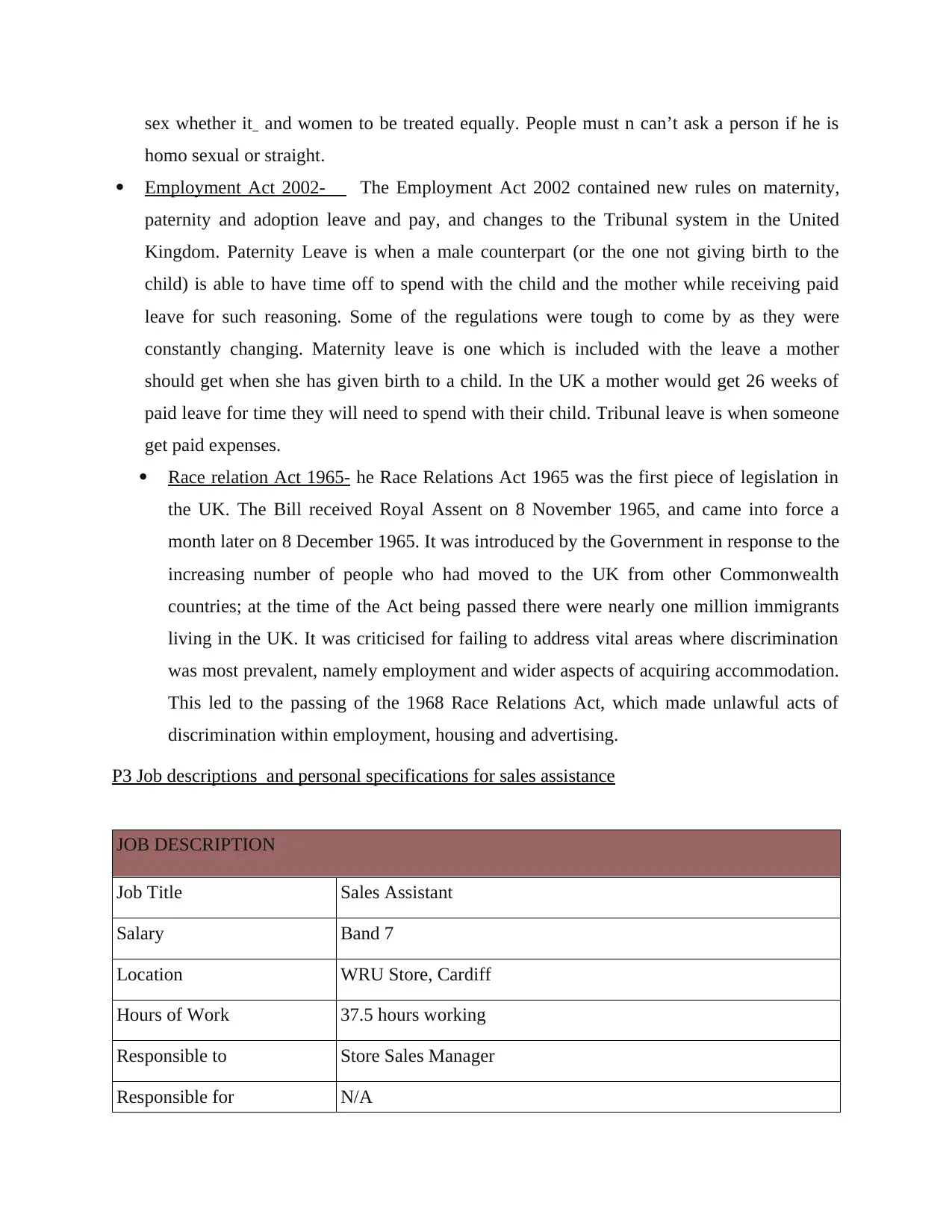
sex whether it and women to be treated equally. People must n can’t ask a person if he is
homo sexual or straight.
Employment Act 2002- The Employment Act 2002 contained new rules on maternity,
paternity and adoption leave and pay, and changes to the Tribunal system in the United
Kingdom. Paternity Leave is when a male counterpart (or the one not giving birth to the
child) is able to have time off to spend with the child and the mother while receiving paid
leave for such reasoning. Some of the regulations were tough to come by as they were
constantly changing. Maternity leave is one which is included with the leave a mother
should get when she has given birth to a child. In the UK a mother would get 26 weeks of
paid leave for time they will need to spend with their child. Tribunal leave is when someone
get paid expenses.
Race relation Act 1965- he Race Relations Act 1965 was the first piece of legislation in
the UK. The Bill received Royal Assent on 8 November 1965, and came into force a
month later on 8 December 1965. It was introduced by the Government in response to the
increasing number of people who had moved to the UK from other Commonwealth
countries; at the time of the Act being passed there were nearly one million immigrants
living in the UK. It was criticised for failing to address vital areas where discrimination
was most prevalent, namely employment and wider aspects of acquiring accommodation.
This led to the passing of the 1968 Race Relations Act, which made unlawful acts of
discrimination within employment, housing and advertising.
P3 Job descriptions and personal specifications for sales assistance
JOB DESCRIPTION
Job Title Sales Assistant
Salary Band 7
Location WRU Store, Cardiff
Hours of Work 37.5 hours working
Responsible to Store Sales Manager
Responsible for N/A
homo sexual or straight.
Employment Act 2002- The Employment Act 2002 contained new rules on maternity,
paternity and adoption leave and pay, and changes to the Tribunal system in the United
Kingdom. Paternity Leave is when a male counterpart (or the one not giving birth to the
child) is able to have time off to spend with the child and the mother while receiving paid
leave for such reasoning. Some of the regulations were tough to come by as they were
constantly changing. Maternity leave is one which is included with the leave a mother
should get when she has given birth to a child. In the UK a mother would get 26 weeks of
paid leave for time they will need to spend with their child. Tribunal leave is when someone
get paid expenses.
Race relation Act 1965- he Race Relations Act 1965 was the first piece of legislation in
the UK. The Bill received Royal Assent on 8 November 1965, and came into force a
month later on 8 December 1965. It was introduced by the Government in response to the
increasing number of people who had moved to the UK from other Commonwealth
countries; at the time of the Act being passed there were nearly one million immigrants
living in the UK. It was criticised for failing to address vital areas where discrimination
was most prevalent, namely employment and wider aspects of acquiring accommodation.
This led to the passing of the 1968 Race Relations Act, which made unlawful acts of
discrimination within employment, housing and advertising.
P3 Job descriptions and personal specifications for sales assistance
JOB DESCRIPTION
Job Title Sales Assistant
Salary Band 7
Location WRU Store, Cardiff
Hours of Work 37.5 hours working
Responsible to Store Sales Manager
Responsible for N/A
⊘ This is a preview!⊘
Do you want full access?
Subscribe today to unlock all pages.

Trusted by 1+ million students worldwide
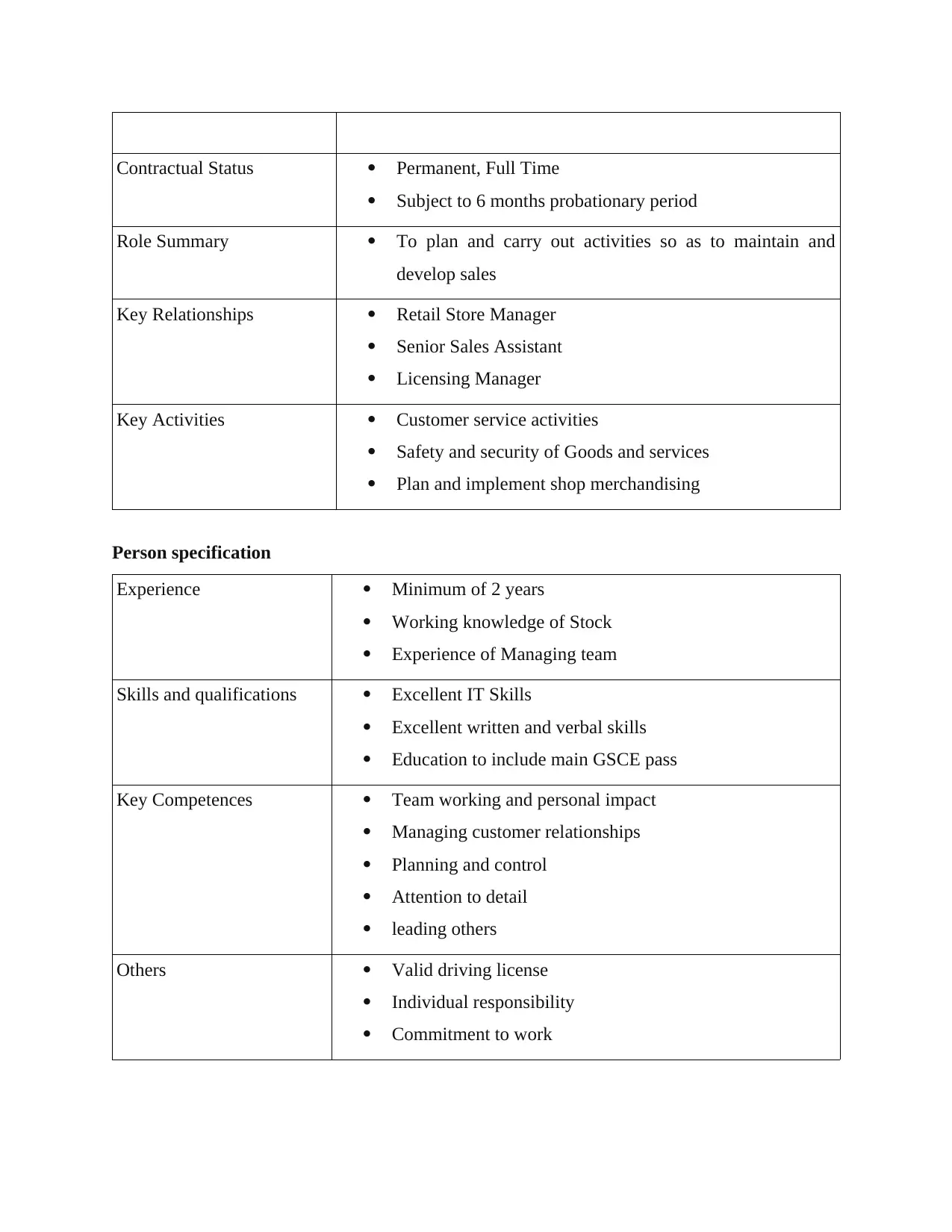
Contractual Status Permanent, Full Time
Subject to 6 months probationary period
Role Summary To plan and carry out activities so as to maintain and
develop sales
Key Relationships Retail Store Manager
Senior Sales Assistant
Licensing Manager
Key Activities Customer service activities
Safety and security of Goods and services
Plan and implement shop merchandising
Person specification
Experience Minimum of 2 years
Working knowledge of Stock
Experience of Managing team
Skills and qualifications Excellent IT Skills
Excellent written and verbal skills
Education to include main GSCE pass
Key Competences Team working and personal impact
Managing customer relationships
Planning and control
Attention to detail
leading others
Others Valid driving license
Individual responsibility
Commitment to work
Subject to 6 months probationary period
Role Summary To plan and carry out activities so as to maintain and
develop sales
Key Relationships Retail Store Manager
Senior Sales Assistant
Licensing Manager
Key Activities Customer service activities
Safety and security of Goods and services
Plan and implement shop merchandising
Person specification
Experience Minimum of 2 years
Working knowledge of Stock
Experience of Managing team
Skills and qualifications Excellent IT Skills
Excellent written and verbal skills
Education to include main GSCE pass
Key Competences Team working and personal impact
Managing customer relationships
Planning and control
Attention to detail
leading others
Others Valid driving license
Individual responsibility
Commitment to work
Paraphrase This Document
Need a fresh take? Get an instant paraphrase of this document with our AI Paraphraser
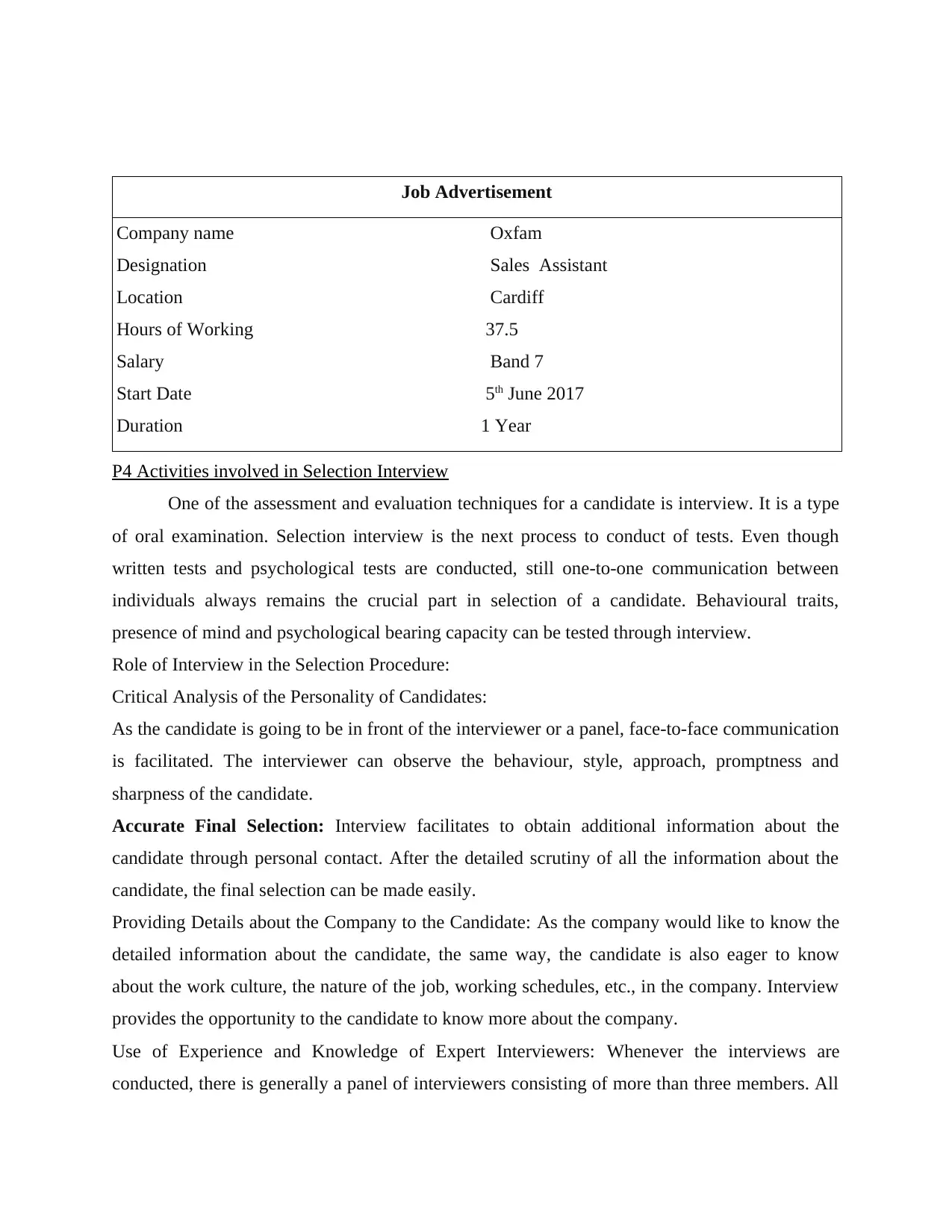
Job Advertisement
Company name
Designation
Location
Hours of Working
Salary
Start Date
Duration
Oxfam
Sales Assistant
Cardiff
37.5
Band 7
5th June 2017
1 Year
P4 Activities involved in Selection Interview
One of the assessment and evaluation techniques for a candidate is interview. It is a type
of oral examination. Selection interview is the next process to conduct of tests. Even though
written tests and psychological tests are conducted, still one-to-one communication between
individuals always remains the crucial part in selection of a candidate. Behavioural traits,
presence of mind and psychological bearing capacity can be tested through interview.
Role of Interview in the Selection Procedure:
Critical Analysis of the Personality of Candidates:
As the candidate is going to be in front of the interviewer or a panel, face-to-face communication
is facilitated. The interviewer can observe the behaviour, style, approach, promptness and
sharpness of the candidate.
Accurate Final Selection: Interview facilitates to obtain additional information about the
candidate through personal contact. After the detailed scrutiny of all the information about the
candidate, the final selection can be made easily.
Providing Details about the Company to the Candidate: As the company would like to know the
detailed information about the candidate, the same way, the candidate is also eager to know
about the work culture, the nature of the job, working schedules, etc., in the company. Interview
provides the opportunity to the candidate to know more about the company.
Use of Experience and Knowledge of Expert Interviewers: Whenever the interviews are
conducted, there is generally a panel of interviewers consisting of more than three members. All
Company name
Designation
Location
Hours of Working
Salary
Start Date
Duration
Oxfam
Sales Assistant
Cardiff
37.5
Band 7
5th June 2017
1 Year
P4 Activities involved in Selection Interview
One of the assessment and evaluation techniques for a candidate is interview. It is a type
of oral examination. Selection interview is the next process to conduct of tests. Even though
written tests and psychological tests are conducted, still one-to-one communication between
individuals always remains the crucial part in selection of a candidate. Behavioural traits,
presence of mind and psychological bearing capacity can be tested through interview.
Role of Interview in the Selection Procedure:
Critical Analysis of the Personality of Candidates:
As the candidate is going to be in front of the interviewer or a panel, face-to-face communication
is facilitated. The interviewer can observe the behaviour, style, approach, promptness and
sharpness of the candidate.
Accurate Final Selection: Interview facilitates to obtain additional information about the
candidate through personal contact. After the detailed scrutiny of all the information about the
candidate, the final selection can be made easily.
Providing Details about the Company to the Candidate: As the company would like to know the
detailed information about the candidate, the same way, the candidate is also eager to know
about the work culture, the nature of the job, working schedules, etc., in the company. Interview
provides the opportunity to the candidate to know more about the company.
Use of Experience and Knowledge of Expert Interviewers: Whenever the interviews are
conducted, there is generally a panel of interviewers consisting of more than three members. All
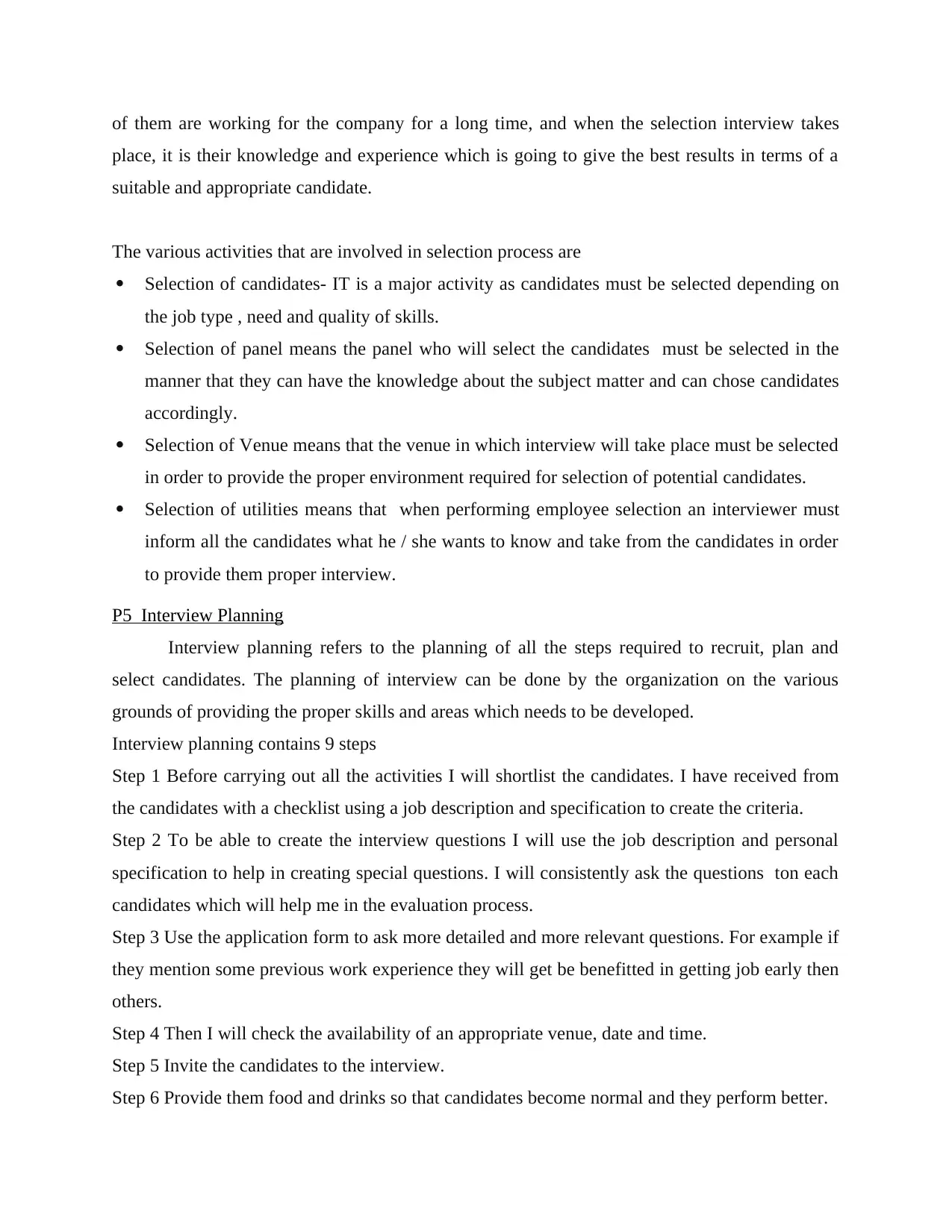
of them are working for the company for a long time, and when the selection interview takes
place, it is their knowledge and experience which is going to give the best results in terms of a
suitable and appropriate candidate.
The various activities that are involved in selection process are
Selection of candidates- IT is a major activity as candidates must be selected depending on
the job type , need and quality of skills.
Selection of panel means the panel who will select the candidates must be selected in the
manner that they can have the knowledge about the subject matter and can chose candidates
accordingly.
Selection of Venue means that the venue in which interview will take place must be selected
in order to provide the proper environment required for selection of potential candidates.
Selection of utilities means that when performing employee selection an interviewer must
inform all the candidates what he / she wants to know and take from the candidates in order
to provide them proper interview.
P5 Interview Planning
Interview planning refers to the planning of all the steps required to recruit, plan and
select candidates. The planning of interview can be done by the organization on the various
grounds of providing the proper skills and areas which needs to be developed.
Interview planning contains 9 steps
Step 1 Before carrying out all the activities I will shortlist the candidates. I have received from
the candidates with a checklist using a job description and specification to create the criteria.
Step 2 To be able to create the interview questions I will use the job description and personal
specification to help in creating special questions. I will consistently ask the questions ton each
candidates which will help me in the evaluation process.
Step 3 Use the application form to ask more detailed and more relevant questions. For example if
they mention some previous work experience they will get be benefitted in getting job early then
others.
Step 4 Then I will check the availability of an appropriate venue, date and time.
Step 5 Invite the candidates to the interview.
Step 6 Provide them food and drinks so that candidates become normal and they perform better.
place, it is their knowledge and experience which is going to give the best results in terms of a
suitable and appropriate candidate.
The various activities that are involved in selection process are
Selection of candidates- IT is a major activity as candidates must be selected depending on
the job type , need and quality of skills.
Selection of panel means the panel who will select the candidates must be selected in the
manner that they can have the knowledge about the subject matter and can chose candidates
accordingly.
Selection of Venue means that the venue in which interview will take place must be selected
in order to provide the proper environment required for selection of potential candidates.
Selection of utilities means that when performing employee selection an interviewer must
inform all the candidates what he / she wants to know and take from the candidates in order
to provide them proper interview.
P5 Interview Planning
Interview planning refers to the planning of all the steps required to recruit, plan and
select candidates. The planning of interview can be done by the organization on the various
grounds of providing the proper skills and areas which needs to be developed.
Interview planning contains 9 steps
Step 1 Before carrying out all the activities I will shortlist the candidates. I have received from
the candidates with a checklist using a job description and specification to create the criteria.
Step 2 To be able to create the interview questions I will use the job description and personal
specification to help in creating special questions. I will consistently ask the questions ton each
candidates which will help me in the evaluation process.
Step 3 Use the application form to ask more detailed and more relevant questions. For example if
they mention some previous work experience they will get be benefitted in getting job early then
others.
Step 4 Then I will check the availability of an appropriate venue, date and time.
Step 5 Invite the candidates to the interview.
Step 6 Provide them food and drinks so that candidates become normal and they perform better.
⊘ This is a preview!⊘
Do you want full access?
Subscribe today to unlock all pages.

Trusted by 1+ million students worldwide

Step 7 Structure of the interview includes introduction about yourself, general questions related
to course and field.
Step 8 Using the scoring technique evaluate the candidates on the basis of knowledhge and skills
they possess.
Step 9 Finally providing them the information about job confirmation through mails and
telephones.
CONCLUSION
Workforce planning is vital if a business is to meet its future demands for staff. It allows a
business time to train existing staff to take on new responsibilities and to recruit new staff to fill
vacancies or to meet skill shortages. Tesco is a major international company with many job
opportunities, including management, graduate, school leaver and apprentice posts. Tesco
needs to have people with the right skills and behaviours to support its growth and
developmental. Tesco has clear organisational structures, detailed job descriptions and person
specifications. It provides user-friendly ways of applying for jobs and a consistent approach to
recruitment and selection. This means it can manage its changing demand for staff.
to course and field.
Step 8 Using the scoring technique evaluate the candidates on the basis of knowledhge and skills
they possess.
Step 9 Finally providing them the information about job confirmation through mails and
telephones.
CONCLUSION
Workforce planning is vital if a business is to meet its future demands for staff. It allows a
business time to train existing staff to take on new responsibilities and to recruit new staff to fill
vacancies or to meet skill shortages. Tesco is a major international company with many job
opportunities, including management, graduate, school leaver and apprentice posts. Tesco
needs to have people with the right skills and behaviours to support its growth and
developmental. Tesco has clear organisational structures, detailed job descriptions and person
specifications. It provides user-friendly ways of applying for jobs and a consistent approach to
recruitment and selection. This means it can manage its changing demand for staff.
Paraphrase This Document
Need a fresh take? Get an instant paraphrase of this document with our AI Paraphraser

REFERENCES
Books and Journals
Chaneta, I., 2014. Recruitment and Selection. International Journal of Management, IT and
Engineering,4(2), p.289.
Costen, W.M., 2012. Recruitment and Selection. The Encyclopedia of Human Resource
Management: Short Entries, pp.379-387.
Doornenbal, E., Stitselaar, W. and et. Al 2012. Recruitment & Selection. Christian University of
Applied Sciences, pp.1-20.
McGraw, P., 2011. Recruitment and selection. Australian Master Human Resource Guide,
pp.217-234.
Rees, G. and Rumbles, S., 2010. Recruitment and selection. Rees, G. and French, R. Leading,
Managing and Developing People, pp.169-190.
Taylor, S., 2014. Recruitment and selection. Strategic Human Resource Management: An
International Perspective,10(6), pp.139-14.
ONLINE
Human resources: recruitment and selection 2017[ONLINE] Available through
<http://www.open.edu/openlearn/money-management/management/human-resources/
human-resources-recruitment-and-selection/content-section-5> [Accessed on 5th June
2017]
Recruitment and selection 2017 [ONLINE] Available through
<http://businesscasestudies.co.uk/tesco/recruitment-and-selection/introduction.html>
[Accessed on 5th June 2017]
Books and Journals
Chaneta, I., 2014. Recruitment and Selection. International Journal of Management, IT and
Engineering,4(2), p.289.
Costen, W.M., 2012. Recruitment and Selection. The Encyclopedia of Human Resource
Management: Short Entries, pp.379-387.
Doornenbal, E., Stitselaar, W. and et. Al 2012. Recruitment & Selection. Christian University of
Applied Sciences, pp.1-20.
McGraw, P., 2011. Recruitment and selection. Australian Master Human Resource Guide,
pp.217-234.
Rees, G. and Rumbles, S., 2010. Recruitment and selection. Rees, G. and French, R. Leading,
Managing and Developing People, pp.169-190.
Taylor, S., 2014. Recruitment and selection. Strategic Human Resource Management: An
International Perspective,10(6), pp.139-14.
ONLINE
Human resources: recruitment and selection 2017[ONLINE] Available through
<http://www.open.edu/openlearn/money-management/management/human-resources/
human-resources-recruitment-and-selection/content-section-5> [Accessed on 5th June
2017]
Recruitment and selection 2017 [ONLINE] Available through
<http://businesscasestudies.co.uk/tesco/recruitment-and-selection/introduction.html>
[Accessed on 5th June 2017]
1 out of 11